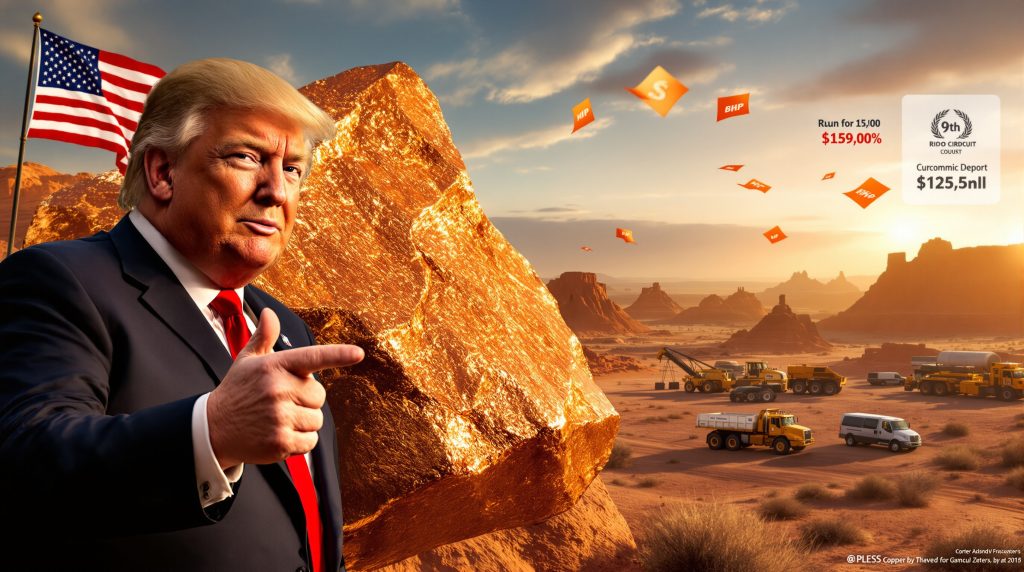The Resolution Copper Project: America's Next Copper Giant
The Resolution Copper project represents one of the most significant copper mining developments in North America, promising substantial economic benefits while simultaneously generating intense controversy. Located near Superior, Arizona, this joint venture between mining giants Rio Tinto and BHP aims to tap into one of the largest undeveloped copper deposits in the world.
With an estimated yield of 40 billion pounds of copper over a 40-year operational lifespan, the project could meet approximately 25% of America's copper demand. This massive undertaking requires a federal land transfer to proceed—a process that has become the focal point of legal, cultural, and political tension.
A Strategic Asset in America's Resource Portfolio
Resolution Copper stands as a potentially crucial component in America's domestic mineral security strategy. As surging copper demand continues worldwide—driven by renewable energy technologies, electric vehicles, and infrastructure development—securing reliable domestic supplies has become increasingly important.
The project's Arizona location positions it as an accessible domestic resource, reducing reliance on international copper sources that may be subject to supply chain disruptions or geopolitical tensions. For supporters, Resolution Copper represents not just economic development but a strategic national asset.
Industry analysts note that a single large-scale wind turbine can require up to 4.7 tons of copper, while electric vehicles use approximately four times the copper of conventional vehicles. This escalating demand underscores the strategic significance of developing major copper resources within U.S. borders.
Why the Land Transfer Has Sparked Controversy
The proposed copper mine has encountered significant obstacles, most notably a recent ruling from the San Francisco-based 9th U.S. Circuit Court of Appeals that temporarily blocked the federal land transfer necessary for development. This legal decision represents a major setback for the mining companies and highlights the complex web of competing interests surrounding the project.
Legal Challenges Mounting
The court's decision prevents immediate development of the project site, creating uncertainty about the timeline for bringing this copper resource to market. The ruling represents the latest chapter in a years-long legal battle over the approval process.
At the heart of the legal controversy is whether sufficient environmental impact studies were conducted and whether the federal government fulfilled its obligation to consult with affected stakeholders. The court's temporary block suggests judges found merit in claims that proper procedures weren't followed during the approval process.
Legal experts note that this case could establish important precedents regarding resource development on federal lands, potentially affecting numerous other mining projects throughout the western United States.
Indigenous Rights at the Center of Debate
Perhaps the most emotionally charged aspect of the controversy involves the project's impact on lands considered sacred by several Native American tribes, particularly the San Carlos Apache. The area known as Oak Flat (Chi'chil Biłdagoteel) holds profound cultural and religious significance.
Many tribal members and supporters argue that the destruction of this sacred site would constitute an irreparable loss of cultural heritage and a violation of religious freedom. Traditional ceremonies have been conducted at Oak Flat for generations, and the site contains numerous culturally significant features.
Critics of the land transfer process point to historical patterns of disregarding Indigenous rights in favor of resource extraction, framing this as the latest example of a troubling legacy. They maintain that adequate tribal consultation was not conducted before approval decisions were made.
Environmental Concerns Compound Controversy
Beyond cultural considerations, significant environmental questions surround the Resolution Copper project. The proposed block cave mining technique would eventually create a subsidence crater approximately two miles wide and up to 1,000 feet deep.
Water usage represents another major concern in drought-prone Arizona. Mining operations typically require substantial water resources for processing ore, raising questions about long-term sustainability in a region already facing water scarcity challenges.
Environmental groups have highlighted potential threats to local groundwater quality and surrounding ecosystems. The project area provides habitat for numerous plant and animal species, including some that are threatened or endangered, adding another layer to the environmental debate.
Trump's Fiery Response to the Court Decision
Former President Donald Trump has weighed in forcefully on the Resolution Copper controversy, directing sharp criticism at the 9th Circuit Court of Appeals following their decision to temporarily block the land transfer.
Accusations of Judicial Activism
Trump characterized the 9th Circuit Court as "radical left" in public statements, framing the decision as politically motivated rather than based on legal merits. This rhetoric aligns with his broader criticisms of the 9th Circuit during his presidency, when he frequently accused the court of judicial overreach.
"The Radical Left 9th Circuit Court just ruled against the biggest copper mine in the United States," Trump stated on his Truth Social platform, setting the tone for his opposition to the ruling.
Framing Opposition as Anti-American
In particularly striking language, Trump suggested that opponents of the Resolution Copper project are "Anti-American, and representing other copper competitive countries." This framing attempts to position the mining project as a matter of national interest and economic patriotism.
By suggesting that opposition serves foreign interests, Trump's rhetoric elevates what might otherwise be seen as a regional dispute into a matter of national economic security and competition. This narrative resonates with his broader "America First" positioning on resource development and manufacturing.
Consistent with Pro-Development Stance
Trump's vigorous defense of the Resolution Copper project aligns with his administration's previous efforts to streamline permitting processes for resource extraction projects. During his presidency, Trump consistently advocated for reduced regulatory barriers to mining, oil, and gas development on federal lands.
His support for the project represents continuity with his previous positions on natural resource development, emphasizing economic benefits and domestic production over environmental concerns or Indigenous rights claims.
Economic Implications: Weighing Costs and Benefits
The Resolution Copper project presents a complex economic equation, with significant potential benefits accompanied by substantial costs and uncertainties.
Job Creation and Economic Stimulus
Proponents emphasize the project's economic potential for Arizona and the broader U.S. economy. According to company projections, Resolution Copper would create approximately 1,500 direct jobs during peak construction and about 750 permanent positions once operational.
The economic ripple effects could generate thousands of additional indirect jobs in supporting industries and services. In a region that has experienced the boom-and-bust cycles common to mining communities, these employment opportunities represent significant economic stimulus.
Tax revenue generated by the project would benefit local communities, providing funding for schools, infrastructure, and public services. Estimates suggest the mine could generate billions in tax revenue over its operational lifetime.
Global Copper Market Dynamics
The timing of Resolution Copper's development coincides with unprecedented demand growth in global copper markets. As the world transitions toward renewable energy and electrification, copper has become an increasingly critical resource.
Industry forecasts suggest a potential copper supply gap of 8 million metric tons by 2032 if new projects don't come online. Resolution Copper could play a significant role in addressing this global copper supply forecast, potentially stabilizing prices and ensuring availability for critical technologies.
For investors and mining companies, these market dynamics make the project particularly attractive despite the regulatory challenges and development costs. The long-term outlook for copper price insights remains strong, enhancing the economic viability of even complex mining projects.
Investment Challenges Amid Uncertainty
For Rio Tinto and BHP, the ongoing legal battles create significant economic uncertainty. Modern mining projects require billions in upfront capital before generating returns, and regulatory delays directly impact project economics.
The uncertainty surrounding the land transfer affects investment timelines, potentially increasing costs and reducing the project's net present value. Shareholders and corporate leaders must weigh these risks against the substantial long-term potential of the copper resource.
Industry analysts note that regulatory uncertainty represents one of the most significant challenges for mining investment in the United States compared to other major mining jurisdictions, potentially affecting future development decisions beyond this specific project.
Resolution Copper in the Context of Resource Politics
The battle over Resolution Copper exemplifies broader tensions in American resource politics, touching on issues of sovereignty, security, and competing visions for public lands.
Critical Minerals and National Security
Copper has been identified as a critical mineral by the U.S. government due to its importance for defense applications, energy infrastructure, and advanced technologies. Domestic production capacity has increasingly been framed as a matter of national security rather than purely economic development.
This security-focused framing has gained traction across political lines, though significant disagreements remain about how to balance resource development with environmental protection and Indigenous rights. Resolution Copper has become a flashpoint in this ongoing debate.
Policymakers increasingly recognize that mineral supply chains represent potential vulnerabilities in an era of great power competition and technological transformation. This perspective lends additional weight to arguments favoring domestic resource development.
Political Polarization Over Public Lands
The Resolution Copper controversy reflects deepening political divisions regarding federal land management. Conservative voices often emphasize resource development and economic use, while progressive perspectives tend to prioritize conservation, Indigenous rights, and environmental protection.
These competing visions play out in public discourse, legislative battles, and court decisions regarding projects like Resolution Copper. The 9th Circuit Court decision and Trump's response exemplify how resource development has become increasingly partisan.
Legal experts note that the oscillation between pro-development and pro-conservation policies across changing administrations creates significant challenges for long-term project planning, particularly for developments that span multiple presidential terms.
International Competition Implications
Trump's suggestion that opposition to Resolution Copper serves foreign copper producers highlights the international dimensions of resource development politics. Major copper producing nations like Chile, Peru, and China maintain significant market advantages over U.S. production.
Global competition for mineral resources has intensified as nations seek to secure supply chains for strategic technologies. This competition influences domestic policy debates about the balance between development and protection of natural resources.
Industry analysts note that copper mining faces fewer regulatory hurdles in many competing nations, potentially creating competitive disadvantages for U.S. production. However, these jurisdictions often have less stringent environmental and labor standards, raising ethical questions about offshoring resource extraction impacts.
The Uncertain Path Forward
The future of the Resolution Copper project remains uncertain as legal challenges continue and stakeholders navigate competing interests and values.
Legal Complexities and Potential Resolutions
The temporary block on the land transfer represents just one stage in what will likely be a protracted legal process. Appeals and counter-appeals could potentially reach the Supreme Court, extending the timeline for final resolution.
Additional environmental reviews may be required before the project can proceed, potentially addressing concerns raised by the court regarding the adequacy of previous assessments. These supplemental studies could take years to complete, further delaying development.
Legal experts note that the case highlights tensions between different federal statutes—including the National Environmental Policy Act, the National Historic Preservation Act, and various mining laws—creating complex jurisdictional questions that courts must unravel.
Stakeholder Engagement and Potential Compromise
Moving forward, Resolution Copper's developers may pursue enhanced consultation with affected communities, particularly the Indigenous tribes with cultural connections to the land. More robust engagement could potentially address some concerns, though fundamental disagreements about the project may remain irreconcilable.
Alternative approaches to development might emerge, potentially including modifications to mining methods, enhanced cultural heritage protection measures, or more substantial economic benefit-sharing arrangements with affected communities.
Environmental mitigation plans will likely require enhancement to address concerns raised through the legal process. Water conservation technologies, habitat protection measures, and long-term monitoring programs could help address some environmental objections.
Implications for Future Resource Development
The Resolution Copper case will likely influence approaches to other contested mining projects on federal lands. The legal precedents established through this process could shape how agencies conduct environmental reviews and tribal consultations for decades to come.
The high-profile nature of the controversy may prompt legislative efforts to clarify the legal framework for resource development on public lands. Congressional action could potentially resolve some ambiguities in current law, though political divisions make comprehensive reform challenging.
Regardless of the ultimate outcome, the Resolution Copper controversy illustrates the complex balancing act required when weighing economic development against environmental protection, cultural preservation, and tribal sovereignty—a balance that will continue to challenge policymakers, courts, and communities across the American West.
Understanding the Resolution Copper Controversy: Key Questions Answered
What specific land would be transferred for the project?
The land transfer involves approximately 2,400 acres of federal land in the Tonto National Forest, including the area known as Oak Flat. In exchange, Resolution Copper would transfer about 5,300 acres of private land to the federal government for conservation purposes.
This exchange was authorized by Congress in 2014 as part of the National Defense Authorization Act, a legislative maneuver that critics argue circumvented normal environmental review processes. The transferred land would allow for the development of what would become one of America's largest copper mines.
How would the mining operation affect the landscape?
Resolution Copper plans to use a method called block cave mining, which involves excavating beneath the ore body and allowing it to collapse under its own weight. This technique is more economical for deep deposits but creates significant surface impacts.
Over time, this mining method would create a subsidence crater approximately two miles wide and up to 1,000 feet deep. This permanent alteration of the landscape represents one of the most significant environmental concerns associated with the project.
What are the specific tribal objections to the project?
Several tribes, particularly the San Carlos Apache, consider Oak Flat sacred ground used for religious ceremonies, gathering of traditional medicines, and cultural practices. Tribal members have described the area as equivalent to a church or temple—a sacred space fundamental to their religious and cultural identity.
Beyond religious concerns, tribes have raised issues regarding potential impacts on archaeological sites, traditional cultural properties, and ancestral connections to the land that date back thousands of years. Many view the transfer as continuing a historical pattern of dispossessing Indigenous peoples of their sacred spaces.
How has the project progressed through regulatory processes?
The Resolution Copper project has followed a complex regulatory path spanning multiple administrations. The land swap was initially authorized during the Obama administration through its inclusion in the 2014 National Defense Authorization Act.
The Trump administration worked to advance the environmental review process, publishing the Final Environmental Impact Statement in January 2021. This action started a 60-day countdown to the land exchange, but the Biden administration subsequently withdrew the environmental impact statement for additional review, further delaying the process.
What factors are driving increased copper demand?
Copper demand is projected to grow dramatically in coming decades, primarily driven by the global energy transition. Electric vehicles use approximately four times as much copper as conventional vehicles, while renewable energy systems like wind and solar require significantly more copper than traditional power generation.
Additionally, expanding digital infrastructure, including data centers and telecommunications networks, continues to drive copper consumption. These combined factors create what industry analysts call a "supercycle" for copper demand, potentially supporting higher prices and increased development interest.
Note on Development Timeline: The Resolution Copper project has already been in development for over 15 years, demonstrating the extended timeframes typical for major mining projects. Even if legal hurdles are resolved favorably for the developers, production would likely not begin until the 2030s, given the substantial construction requirements for this complex underground mining operation.
Trump and the Resolution Copper Land Transfer: A Political Lightning Rod
The controversy surrounding the Resolution Copper project and Trump's vocal support for it exemplifies the intensely political nature of resource development decisions on public lands. As copper becomes increasingly critical for energy transition technologies, the tension between development imperatives and environmental/cultural protection will likely intensify.
For investors, policymakers, and communities, the Resolution Copper saga illustrates the complex risk landscape facing major resource projects in the modern regulatory environment. The ultimate resolution of this case will send important signals about America's approach to balancing competing interests in the management of public lands and resources.
As legal proceedings continue and stakeholders advocate for their positions, the Resolution Copper project remains both a potential economic engine and a profound cultural flashpoint—a microcosm of the broader challenges facing copper investment strategies and copper and uranium investments in a divided America.
Ready to Identify the Next Copper Investment Opportunity?
Discovery Alert's proprietary Discovery IQ model instantly notifies investors about significant ASX copper discoveries before the wider market reacts, providing actionable insights on companies that could become tomorrow's copper giants. Explore real-world examples of exceptional investment returns from major mineral discoveries at https://discoveryalert.com.au/discoveries/ and position yourself ahead of the market.




